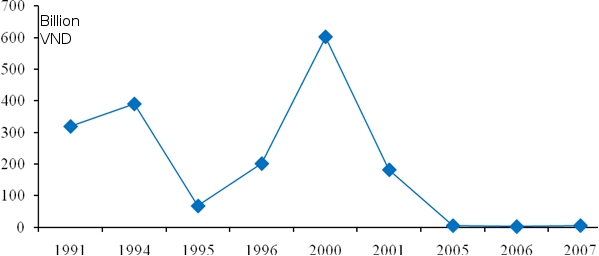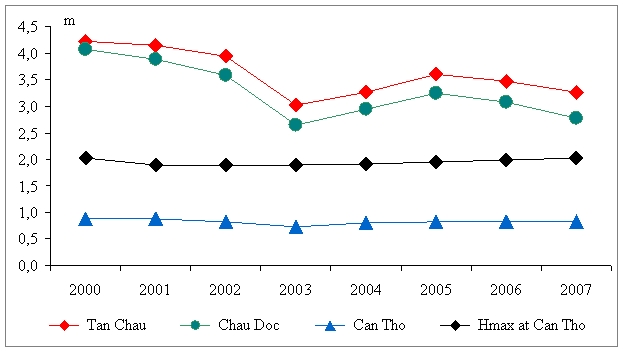Dyke Systems in Can Tho City Show Diverse Impacts
The Mekong Delta is a flood-prone area and floods can cause severe damages to the livelihoods of its population. The historic flood of 2000, in particular, destroyed many rice crops, aquaculture farms, housing and other infrastructure in the flooded areas.
The Mekong Delta is a flood-prone area and floods can cause severe damages to the livelihoods of its population. The historic flood of 2000, in particular, destroyed many rice crops, aquaculture farms, housing and other infrastructure in the flooded areas. The local government’s response to this disaster was to build a dyke system which should prevent such negative impacts and after 2004, dykes were constructed throughout the province. The following chart shows that the new dyke system obviously helped to reduce flood damages and that farmers’ agricultural livelihoods were more secured in the flood protected areas.

Figure 1: Flood damage value in Can Tho City. Source: Department of Agriculture and Rural Development, Can Tho City, 2009
Nevertheless, the new dyke system also has its disadvantages, because it affects flood patterns in various ways. In lower flooding areas for instance, floodwater levels are deeper than ever before, as the hydrological data from local agencies, namely the Can Tho Hydrometeorology Center and the Agriculture and Rural Development Department show. In Can Tho, the average flood levels of the rainy season (September to November) increased from 2004 to 2007. The average flood levels recorded at Chau Doc and Tan Chau Gauging Stations in the upstream areas, however, were still low.

Figure 2: The highest and average flood levels from September until November at four Gauging Stations in the Mekong Delta from 2000-2007.
Source: Can Tho Hydrometeorology Center and Agriculture and Rural Development Department of Can Tho City, 2009
Furthermore, the highest flood crests recorded in Can Tho city after 2000 occurred after the dyke construction. And the highest flood crest, which was recorded in 2007 was equivalent to the highest peak of the 2000 historical flood (2.03m). The dyke system therefore constitutes one of the main factors causing deeper inundation levels for the lower flood areas of the Mekong Delta.
With regard to these results it can be said that the new dyke systems have both, advantages and disadvantages. However, the increase of flood levels definitely constitutes a serious problem for the sustainable development of the lower flooding areas, such as Can Tho City. Moreover, dyke breaks, which occur when flood levels are higher than the dyke crest, represent a serious risk, because the system was designed and constructed based on the 2000 flood data as a worst scenario. Since flood levels are rising, dykes risk breaking one day. In such a case, flood damages will be more severe than ever before. Thus, the current dyke systems need to be reconsidered and the negative impacts for lower flooding areas have to be reduced.
Pham Cong Huu




